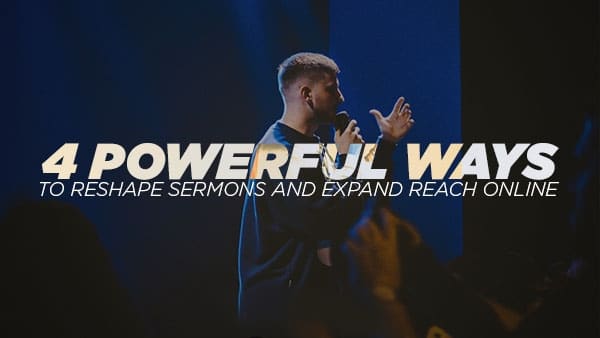
4 Powerful Ways to Reshape Sermons for Social Media
Observing the ministry of Jesus, most of His sermons were made out and about with the people He came across. While Jesus could have kept to the synagogues, I believe this was intentional. Why? Because He knew one thing — no matter how good the truth He had to offer was, it would make no difference if people didn’t hear it.
I believe this is still the case two thousand years later, yet the way we live has changed. Churches spend too much of their God-given time and energy on your sermons every week to let them die within their walls! With the advancement of technology, the Church has an enormous opportunity to reach people where they are with the hope of Jesus.
Below are 4 powerful tools the Church should embrace to free their sermon to make its greatest impact throughout the other 167 hours of the week.
Tool #1: SOCIAL VIDEOS
As a church, it is unmistakably essential to have a social media presence in 2020. Yet, with platforms overrun with content, you have to rethink how you reach people with your message.
That’s where social videos come in! I believe I’m safe in saying that video rules social media in engagement. Don’t take my word for it though, check out these stats:
-
Video consumption on mobile devices increases by 100% each year
-
By 2022, 82% of consumer internet traffic will come from video streaming and content
-
92% of mobile users share videos with others
-
85% of social users watch video content regularly on their devices
-
Social videos have a 135% higher organic reach than images
(Source: SocialMediaToday.com)
Creating high-quality, powerfully appealing social videos out of your sermon will help you maximize your message’s impact and equip your church to quickly and effectively share the Gospel beyond your walls.
These short, sharable videos are uniquely designed to encourage a user to stop scrolling and experience the heart of your message. At Sermon Snaps, we’ve seen social videos increase churches’ engagement by nearly 40% and reach by 300% compared to their regular posts.
Quick Note: Online software like Kapwing can help you create these on your own, or you can take advantage of a service like Sermon Snaps and receive engaging, done-for-you social videos.
Tool #2: PODCASTS
Yes, you’ve probably heard all about podcasts. However, did you know that their popularity has nearly tripled over the last decade into one of the most popular content consumption channels?
Here are some numbers that may surprise you:
- 75% (246 million) of Americans are familiar with podcasts
- 55% (180 million) of Americans have listened to a podcast
- 37% (121 million) listened to a podcast in the last month
- 24% (78 million) listen to podcasts weekly
- Men are more devoted podcast listeners
(Source: PodcastInsights.com)
These numbers should be wildly motivating to churches as you produce the perfect podcast content every week in your sermon. By repurposing your message into a podcast, you can exponentially increase your reach and impact into an entirely new loyal audience.
Podcasts are winning because of their convenience, portability and longevity. They are highly shareable pieces of content that can be taken anywhere and have a long shelf-life.
With just a little intentionality, you can grow your audience with podcasts and have Gospel conversations stocked for many years to come.
Quick Note: Online hosting services like Pod Bean can push your podcast out to all the different streaming platforms.
Tool #3: SHORT-FORM BLOGS
Blogs have been around for decades and aren’t slowing down. However, with mobile devices fast replacing desktops, blogs in their pure, long-form style are being reshaped into short-form content due to our reduced attention spans.
I’m not saying that traditional blogs are dead because they still perform incredibly well, especially for SEO purposes. I’m merely saying that in today’s digital, on-the-go culture, people overwhelmingly prefer to consume content in smaller bites.
With this in mind, it is worth the investment to include short-form blogging into your content strategy for a few reasons:
- They are less time-consuming to create! The ideal length for a short-form blog is 200-600 words as compared to 1500-2000.
- They encourage higher engagement rates and increased sharability across digital platforms.
- They can be published on your website or as actual social media posts giving you greater flexibility and reach.
- You can create multiple short-form blogs from one sermon.
I encourage you to address the felt needs within your messages to point your community to the biblical wisdom they may need. By doing so, you will also begin to build a content archive that will rank in search engines.
Quick Note: Online services like REV will transcribe your sermon video for a modest fee.
Tool #4: EMAILS
Your email list is your most valuable digital tool! It may be the oldest communication tool in your digital toolbox, but email is not going anywhere soon. It remains the most powerful and unique content distribution channel between you and your audience.
Yes, social media has grown exponentially over the last decade, and it deserves your attention. However, nothing can replace the exclusive, invaluable connection email gives you to your audience. Even within this social media era, email continues to outperform across the board:
- Nearly 100% of consumers have an email account; 99% of them check their email every day
- 58% of people check their email as soon as they wake up; 14% do the same for social media
- On average, email reaches 85% of people; social media posts organically reach only 6.5% of people who like your page
- 66% of consumers take action based on an email; 26% through a social media post
(Source: optinmonster.com)
If you aren’t already, I encourage you to begin building your email list and use this tool to continue your sermon conversation between Sundays. The key here is to add value to your audience with every email.
Provide behind-the-scenes insight on your sermon. Recommend supplemental resources to help them grow. Highlight lesser-known ministries within your church that could meet specific felt needs.
Quick Note: Free email services like Mail Chimp and Send Fox can help you send appealing and effective emails!
Bonus Tool: ONLINE PASTOR
With the advancement of technology, the Church has an enormous opportunity to reach people globally for Jesus via the internet. We live in the first generation in history where any church in any city can reach nearly 57% of the world’s population (3.9 billion people). That’s mind-blowing!
Combine that with recently enduring a pandemic, and the Church has every reason to take advantage of technology and move its efforts online. With that, this next item is not a digital tool, but rather a person with digital influence—the Online Pastor.
Recent research by Vanderbloemen shows that only 16% of churches have a role like Online Pastor. I’m not saying that the Church should neglect its physical presence. However, I do believe that this glaring opportunity can no longer be ignored.
Definitions for the role of Online Pastor are still evolving (some part-time, some full-time), but the general idea is someone who intentionally leads and spiritually mentors people within the digital age. They bring a human touch to digital environments like online church services, social media pages, virtual prayer walls, chat messengers, live devotionals and more.
Additionally, serving as ambassadors for the local church, Online Pastors also can help point people to their need for community to help them grow in their faith.
Quick Note: Read all the online church research conducted by Vanderbloemen, Pushpay, and Jay Kranda in this helpful eBook.
I hope this article encourages you to discover ways to reshape your sermons and expand your reach online.




